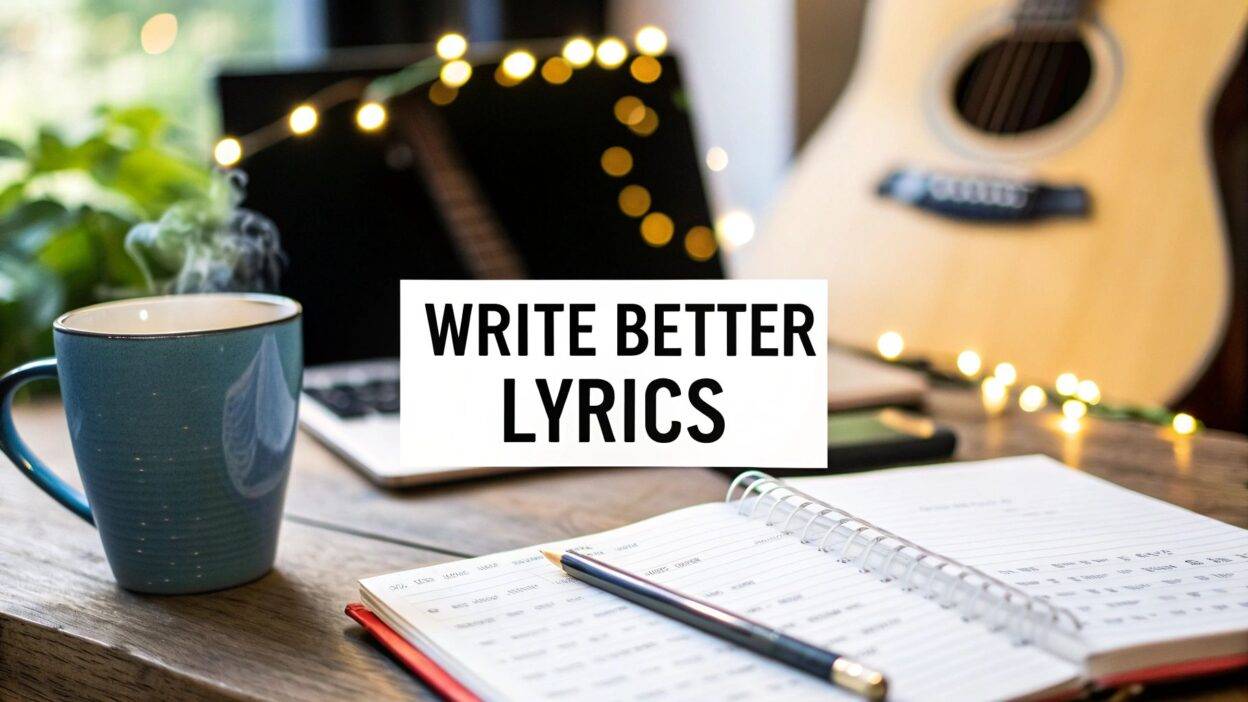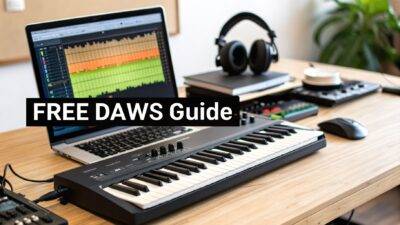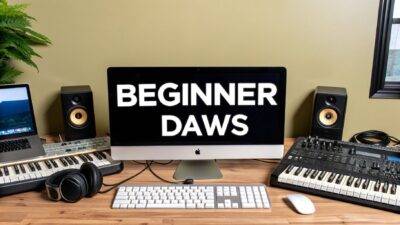If you want to write lyrics that truly connect with people, you have to do some groundwork before you even try to write the first line. The secret isn't just about finding clever rhymes; it's about building a solid foundation. This means zeroing in on a central message, digging up raw ideas from your own experiences, and making sure every single word pulls its weight.
Building Your Foundation for Unforgettable Lyrics
Forget rhyme schemes and song structure for a minute. The most powerful lyrics always start with a strong emotional and conceptual core. Too many songwriters just sit around waiting for that mythical lightning bolt of inspiration to strike. But the pros know better. Learning how to write better lyrics is really about creating a reliable system for generating ideas so you're never stuck staring at a blank page.
Think of this pre-writing stage as a chef doing their prep work. They aren't cooking the main course yet—they're chopping vegetables, prepping sauces, and getting all their raw materials ready. For a songwriter, that means actively collecting thoughts, feelings, and observations from the world around you.
Tapping Into Your Senses and Experiences
One of the best ways to find authentic material is through sensory journaling. This isn't about writing "I was sad today" in a diary. It's about capturing the physical details tied to that feeling.
- What did you see? Maybe it was the way rain streaked down a windowpane.
- What did you hear? The low, lonely hum of a refrigerator in a dead-quiet house.
- What did you feel? The scratchy wool of an old sweater.
- What did you taste or smell? The bitter, acrid smell of burnt coffee.
These specific, tangible details are the bedrock of great imagery. They take an abstract emotion like sadness and ground it in a reality the listener can almost touch and feel. Another fantastic technique is object writing. Just pick a random object in the room and write about it, nonstop, for ten minutes. It’s a great exercise to force your brain to make new creative connections, often uncovering surprising metaphors you can use later. For more great ideas, you can check out some of our other lyric writing tips.
The Big Idea: These exercises aren't about writing a finished song on the spot. They're about building your own personal "database" of images, phrases, and concepts you can pull from whenever inspiration feels dry.
To get a better sense of how different elements come together, this graphic breaks down what makes a song's lyrics truly impactful.
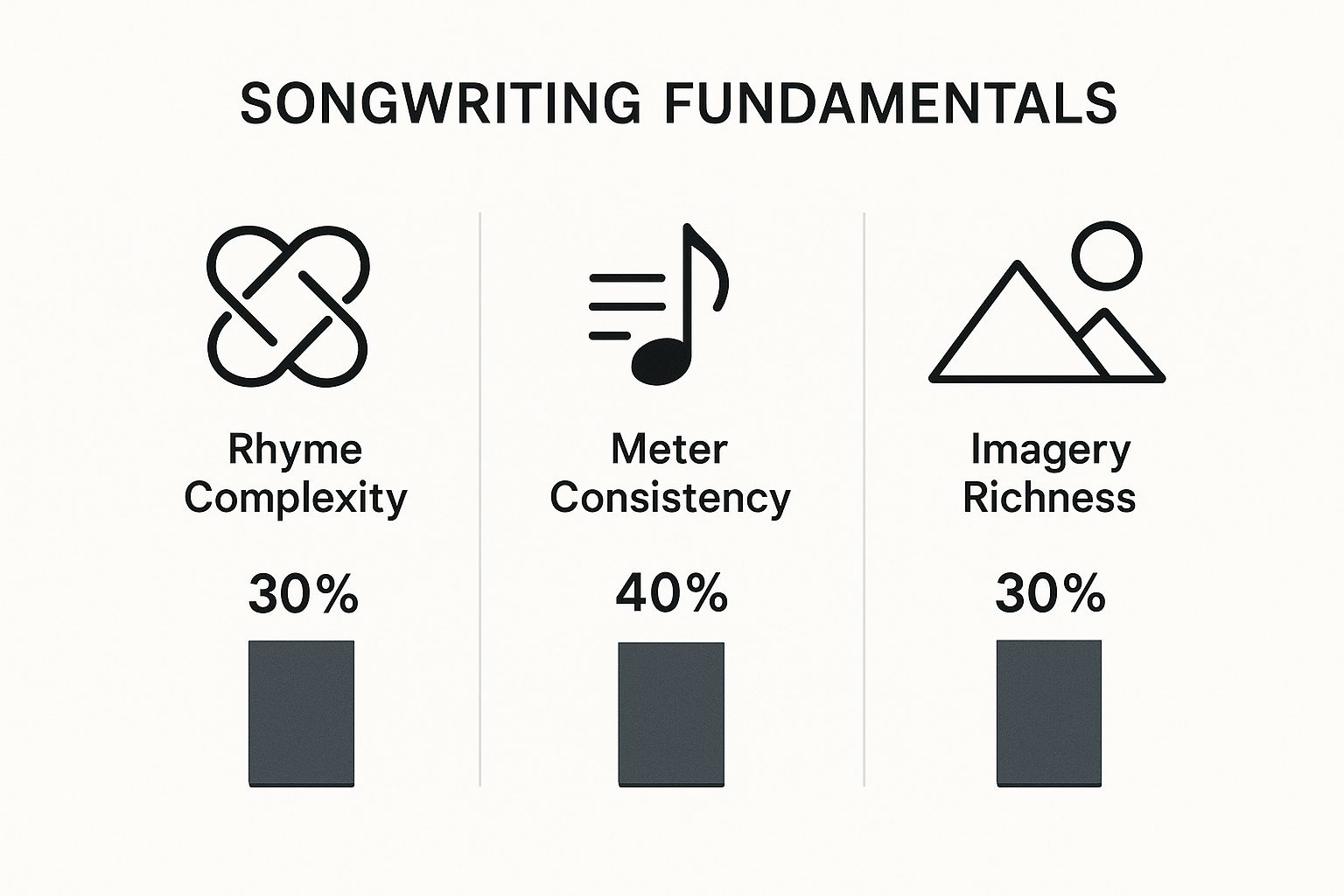
As you can see, things like rich imagery and a consistent meter often carry more weight than just having a complex rhyme scheme. It's all about finding the right balance.
Core Lyric Writing Approaches
Not sure where to begin? Different songs call for different starting points. The table below outlines a few foundational methods to help you find the one that fits your idea best.
| Approach | Core Principle | Best For |
|---|---|---|
| Concept First | Start with a central theme or "big idea." | Story-driven songs, anthems, or tracks with a clear message. |
| Melody First | Write lyrics to fit an existing tune or riff. | Pop, rock, and genres where the musical hook is primary. |
| Imagery First | Build the song around a powerful visual or sensory detail. | Introspective, atmospheric, or emotionally-driven pieces. |
Ultimately, there's no single "right" way to start. The best approach is the one that gets words on the page. Don't be afraid to experiment with all three to see what feels most natural for you and your song.
Defining Your Song's Central Message
Once you've got a pool of raw material, it’s time to decide what your song is really about. What’s the one core idea or feeling you want to leave with your listener? From this point forward, every line you write should serve that central theme in some way.
This doesn't mean your lyrics have to be overly simplistic. Interestingly, recent trends show that modern music is actually moving toward more direct and personal expression. A study of over 350,000 songs from 1970 to today found that lyrics have become simpler, more repetitive, and often more emotionally raw, with a notable increase in feelings like anger. You can read more about these findings in the full study from Smithsonian Magazine.
By setting a clear purpose for your song, you're essentially creating a filter for all your creative choices. Does this line serve the story? Does this metaphor reinforce the core emotion? Doing this foundational work is what keeps your song from wandering aimlessly and ensures it lands with a focused, memorable punch.
Crafting a Compelling Lyrical Narrative

Every truly great song is built on a story. Now, that doesn't always mean a sprawling epic with a neat beginning, middle, and end. Some of the most potent songs just capture a single moment in time—a snapshot of a feeling, a memory, or a pivotal decision. Moving past basic rhyme schemes and into powerful lyricism means getting a handle on narrative. You're building an emotional journey for the listener, one that hooks them from the first line and won't let go.
A strong story gives your song a backbone. It’s the invisible framework that guides the listener, helping them connect with the emotions and characters you’re bringing to life. Without that narrative thread, even the most poetic lines can feel like a jumble of disconnected ideas.
Show, Don't Tell With Sensory Details
If you take one thing away from this, let it be this: show, don't tell. This single principle is often what separates an amateur lyric from a professional one. Instead of flat-out stating an emotion, you need to paint a picture with sensory details that lets the listener experience that feeling for themselves.
Telling is the easy way out, but it creates distance. For example, writing "I was heartbroken" is just a piece of information. It tells the listener what's happening, but it doesn't make them feel it.
Showing, on the other hand, pulls them right into the scene. Think about this instead: "I traced the coffee ring you left on the table / And counted every crack in the kitchen tile." These lines never once say the word "heartbreak," yet the feeling is absolutely palpable. By focusing on small, tangible details, you imply the emotion in a way that’s far more powerful and relatable.
To get in this mindset, start thinking like a film director.
- What does the scene look like? "Streetlights paint the ceiling yellow."
- What can you hear? "The ticking clock is screaming at me."
- What are the physical sensations? "This empty bed is colder than it's ever been."
When you focus on what your song's "character" is seeing, hearing, and touching, you transform an abstract idea into something concrete and emotionally charged.
A listener can argue with a statement like "I'm sad," but they can't argue with an image like "a single sock left in the laundry." Sensory details are undeniable, creating an immediate and personal connection.
Building an Emotional Arc
A killer narrative needs an emotional arc. This is simply a progression that takes your listener on a journey from one feeling to another. It mirrors the structure of any good story by introducing a situation, raising the stakes, and then leading to some kind of release or realization. Even in a standard verse-chorus song, you can build this arc.
Your verses are the perfect place to set the scene with those sensory details we just talked about. This is where you establish the emotional landscape. For instance, your first verse might describe a quiet, lonely room.
The pre-chorus is where you can build tension. It's the musical and lyrical ramp-up that asks a question or raises the stakes, preparing the listener for the emotional payoff of the chorus.
And the chorus? That's your big moment. It delivers the central theme, the emotional gut-punch of your story. It’s the takeaway. Then, you can use the second verse to deepen the story—maybe you introduce a new character, or shift from a past memory to the present moment, showing how things have changed.
Changing Your Narrative Perspective
The point of view you choose will dramatically change how your story lands. Each perspective offers a unique flavor and a different way to connect with your audience.
-
First-Person ("I," "Me," "We"): This is the most common and for good reason—it's incredibly direct. It creates an immediate intimacy, like the singer is sharing a page from their diary. It’s perfect for songs about personal experience, love, or internal conflict.
-
Third-Person ("He," "She," "They"): This perspective turns you, the songwriter, into more of an observer. It lets you describe characters and events with a bit of distance, almost like you're directing a movie. This is a fantastic choice for telling stories about other people's lives or for crafting detailed character studies.
Don't be afraid to mix and match. You could write a verse in the third person to set a scene ("He packs his bags by the pale moonlight") and then slam into a first-person chorus ("And I wonder if you'll ever come back home") to reveal your personal stake in the drama. It’s a sophisticated move that can add surprising layers of depth to your lyrics.
Making Rhyme and Rhythm Serve Your Story
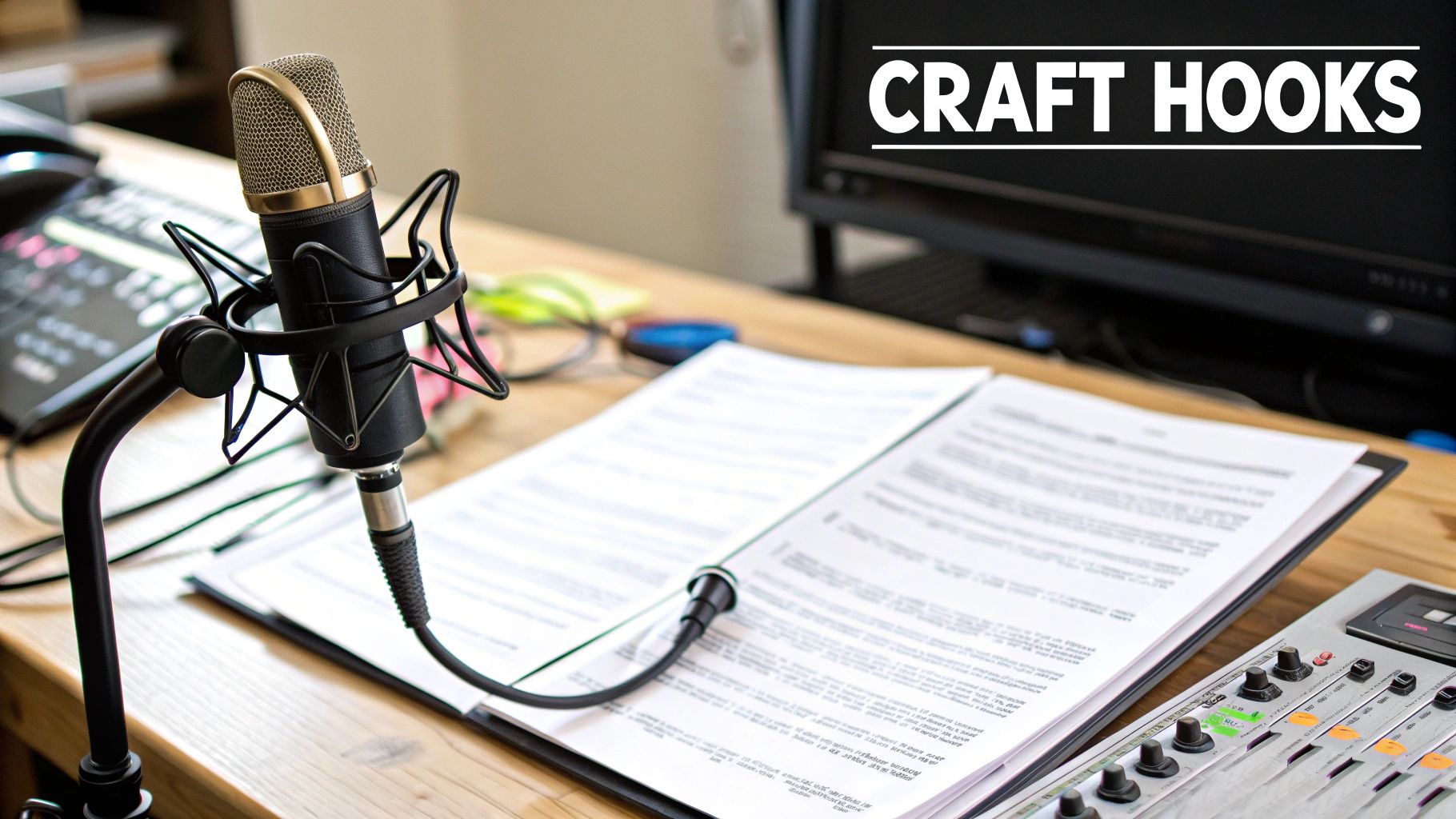
So many aspiring songwriters get hung up on rhyme. They treat it like a rigid rule, often ditching a powerful idea just to find a word that fits the scheme. Here's a secret from a seasoned pro: you need to flip that thinking on its head.
Rhyme and rhythm are your tools, not your masters. Their real job is to add a layer of musicality and punch to the story you’re already telling, not to dictate where that story goes.
When those elements feel forced, they completely shatter the illusion. You know that sound—that clunky, predictable line that feels like it only exists to complete a rhyme. Our goal is to make your lyrics flow so naturally that the rhymes feel like a happy accident, subtly reinforcing your message without waving a giant flag.
Moving Beyond Perfect Rhymes
Your first move is to expand your rhyming vocabulary. Sure, perfect rhymes (like cat and hat) have their moments, but relying on them too much can make your lyrics sound simplistic or, frankly, a bit childish. The best lyricists know that near rhymes often carry more emotional weight and give you so much more creative wiggle room.
Let's break down some more interesting options:
-
Slant Rhymes (or Near Rhymes): These are words that share a similar vowel or consonant sound but aren't a perfect match. Think shape and great, or home and alone. They create a satisfying connection for the listener's ear without being glaringly obvious, which leads to a more mature and sophisticated sound.
-
Internal Rhymes: This is a fantastic trick for adding some rhythmic pop to your lines. It’s when a word in the middle of a line rhymes with a word at the end of the same line or the one right after it. For example: "I took a look at the book you left behind." It creates this subtle musical bounce that makes your lyrics stick.
-
Multisyllabic Rhymes: Rhyming with multiple syllables immediately elevates your craft. It shows a command of language that makes people lean in. Just think of how Eminem masterfully rhymes "calm and ready" with "mom's spaghetti." It’s clever, playful, and incredibly effective.
The real key is to use a mix of these techniques. A solid perfect rhyme can give a satisfying sense of closure at the end of a chorus, while slant and internal rhymes can add texture and depth to your verses. For a much deeper dive into how to structure these, our guide on a rhyme scheme in songs is a resource I highly recommend.
Let Your Rhythm Follow Your Voice
Just as crucial as the words you choose is their rhythm, or meter. This is the pattern of stressed and unstressed syllables that gives your lyrics their natural cadence. The single biggest mistake I see here is writing lyrics that look great on paper but sound completely awkward and unnatural when sung.
So, how do you avoid this trap? Simple. Read your lyrics out loud.
Seriously. Say them. Sing them to a random melody you make up on the spot. Rap them. Do they roll off the tongue like natural speech, or do you have to awkwardly cram words in to make them fit? If a line feels clumsy when you say it, it is.
A lyric should sound like something a real person would actually say. If you wouldn't say it in a conversation, think twice about putting it in a song. Your rhythm should serve the emotion, not the other way around.
Using Rhyme and Rhythm for Emphasis
Once you're comfortable with these tools, you can start using them strategically to make your story hit harder. A strong, well-placed rhyme can act like a spotlight, shining a light on a crucial word or idea.
Imagine you're writing a song about feeling trapped. Let's look at two ways to write it:
- "I'm stuck here in this town / I just want to leave, I'm always feeling down."
- "Every streetlight glows the same / A gilded cage that whispers my name."
The first one is a basic AABB rhyme. It works, but it's not very exciting. The second example, however, uses a more interesting slant rhyme (same / name) to emphasize the central metaphor: the "gilded cage." That rhyme highlights the most powerful image in the couplet, making the feeling of confinement way more vivid and memorable.
Ultimately, your goal is to make these technical elements completely invisible. The listener shouldn't be thinking, "Wow, what a clever rhyme." They should be so lost in the emotion of your story that the rhymes and rhythms just feel like an essential part of the song's DNA. That’s when you know you’re onto something great.
Weaving Imagery and Metaphor Into Your Lyrics
The songs that truly stick with us, the ones we carry for years, rarely just tell us how someone feels. They show us. They paint a picture so vivid it’s like a movie playing in our minds. That’s the power of imagery and metaphor—they turn a simple song into a shared experience.
Achieving this is a bit of a balancing act. The trick is to use details that feel deeply personal and authentic, yet are open enough for listeners to find their own stories inside yours. It’s how a song about one specific heartbreak can end up meaning so much to millions of people.
Ground Your Feelings in the Real World
Great imagery is all about the senses—what you can see, hear, smell, touch, and taste. Instead of just saying you feel nostalgic, show us the "faded photo with the curled-up edges" or let us smell the "rain hitting the hot asphalt." Concrete details like these pull the listener right into the moment with you.
Think about the difference here:
- Telling: "I miss our old apartment."
- Showing: "I swear I still see the ghost of your coat on the hook by the door."
That second line hits so much harder, right? It conjures a sense of loss and memory without ever needing to spell it out. It's specific, visual, and loaded with emotion. This is the heart of writing lyrics that genuinely connect.
How to Brainstorm Fresh Metaphors
Metaphors are fantastic for explaining a big, complicated feeling by comparing it to something tangible. The big risk, though, is leaning on the same old clichés. We’ve all heard love compared to a rose or a fire a thousand times. If you want your lyrics to have an impact, you have to dig a little deeper for fresher comparisons.
Here’s a quick exercise I use all the time to get out of a rut:
- Pick an emotion. Let's go with "anxiety."
- Jot down its qualities. What does it feel like? Maybe it’s a buzzing, a feeling of being trapped, a heavy weight, or a relentless static noise.
- Now, brainstorm things that share those qualities. What else buzzes? A flickering neon sign. What else is trapped? A ship in a bottle. What’s a heavy weight? A diver's lead belt.
Suddenly, you have some truly unique starting points. "This anxiety's a broken neon sign, buzzing in the back of my mind." That’s a far more interesting and memorable image than just saying, "I feel anxious."
My Two Cents: The best metaphors feel a little surprising at first, but then they click and make perfect sense. They give the listener that little "aha!" moment that pulls them deeper into your song's world.
Finding that sweet spot between unique and relatable is key. Interestingly, you can see this dynamic playing out in today's biggest hits. A 2024 analysis from SoundCharts of Spotify’s Top 50 Global songs found that aspirational brand names like Lamborghini and Gucci show up all the time, painting a picture of success. But these are almost always balanced with everyday details, grounding the fantasy in a reality listeners can recognize.
Marrying the Specific to the Universal
The real magic happens when you make your personal story feel like it belongs to everyone. The way you do that is by pairing a hyper-specific detail with a universal human feeling.
| Specific Detail | Universal Feeling |
|---|---|
| "A crumpled receipt from our first date." | Holding onto the past. |
| "The low hum of the vending machine." | Late-night solitude and loneliness. |
| "The cracks spreading on the sidewalk." | Noticing the flaws in a relationship. |
This technique is a cornerstone of brilliant songwriting. You hand the listener a sharp, tangible image—the crumpled receipt—and tie it to an emotion that almost everyone on the planet has felt. The specific detail makes your story feel true and intimate, but the universal emotion is what makes it resonate.
When you master imagery and metaphor, you’re no longer just describing feelings—you’re creating them. You’re giving your audience the building blocks they need to construct the emotional world of your song inside their own heads, making sure your words linger long after the final note fades.
Polishing and Editing: Where Good Lyrics Become Great
There’s a common saying in writing circles that holds especially true for songwriters: "Great writing is rewriting." That first rush of inspiration is magic, the moment you get those raw ideas down on paper. But the real craft, the part that separates the pros from the hobbyists, happens in the edit. This is where you transform a rough sketch into a tight, powerful, and unforgettable song.
Think of your first draft as a block of marble. All the potential is there, but it's still a messy, undefined lump. Editing is your chisel. It’s the slow, careful process of chipping away every word, every line, that isn't essential until the final, powerful form is revealed. This isn't about second-guessing your creativity; it's about refining it so that every single word earns its spot.
The Art of "Killing Your Darlings"
One of the toughest lessons every songwriter has to learn is how to "kill your darlings." This idea, famously attributed to writers like William Faulkner, means you have to be willing to cut lines you personally love if they don't serve the song's core message.
It might be an incredibly clever rhyme you’re proud of, a beautiful turn of phrase, or a piece of imagery that just sounds cool on its own. But if it distracts the listener or pulls focus from the central story, it’s holding the song back. A great song feels like a single, cohesive piece, not just a random collection of impressive lines.
Ask yourself honestly: Does this line actually move the story forward? Does it deepen the emotion? If the answer is no, you have to be brave enough to hit delete.
A song is a conversation with the listener. Any line that breaks that conversational flow or makes them think, "Huh, that was a weird choice," pulls them out of the experience you’re trying to create.
This kind of discipline is a huge part of what it takes to write professional-level songs. If you’re looking for a deeper dive into the whole process, you might find our complete guide on how to write song lyrics helpful.
A Practical Checklist for Self-Editing
To avoid just staring blankly at your page, it helps to have a system. A checklist gives you a structured way to approach the edit, turning a daunting task into a series of manageable steps.
-
Read It Out Loud: This is absolutely non-negotiable. Lyrics are meant to be heard, not just read on a page. When you speak them, you immediately catch awkward phrasing, clunky rhythms, and words that are just plain hard to sing. If you stumble over a line when you say it, you can bet a singer will too.
-
Check for Clarity: Is your story making sense? Does the emotional journey feel logical? It's easy for you to know what you mean, but will someone hearing it for the very first time be able to follow along?
-
Trim the Fat: Get ruthless with your word count. Can you express the same idea more concisely? Instead of a line like, "I'm feeling so sad and lonely in this moment," try something more evocative, like "This room feels a little too big tonight." It’s stronger, paints a better picture, and trusts the listener to connect the dots.
-
Strengthen Your Verbs: Weak verbs are the enemy of dynamic lyrics. Search and destroy passive verbs (like "is," "was," "are") and replace them with active, interesting ones. For example, "The rain was on the window" is fine, but "Rain lashed the windowpane" creates a much more vivid and urgent image.
Get Some Fresh Ears (and Keep Your Words Accurate)
Finally, don't try to edit in a bubble. Once you've pushed your lyrics as far as you can on your own, it’s time for feedback. Play the song for a trusted friend, a fellow songwriter, or a mentor. A fresh set of ears will always catch things you’ve become blind to after hearing it a hundred times.
And once the lyrics are locked in, the job isn’t quite done. Accurate lyric transcriptions can massively boost how fans connect with your music. In fact, data shows a 60% increase in engagement when listeners can read along, with a whopping 88% of fans reporting they sing along when lyrics are available. Discover more insights about these music industry stats on TranscribeTube.
This final stage of polishing—from tough self-editing to seeking outside opinions and ensuring accuracy—is what elevates a good song to a great one. It’s the last, crucial step in learning how to write better lyrics that truly connect with an audience.
Answering Your Most Common Lyric Writing Questions
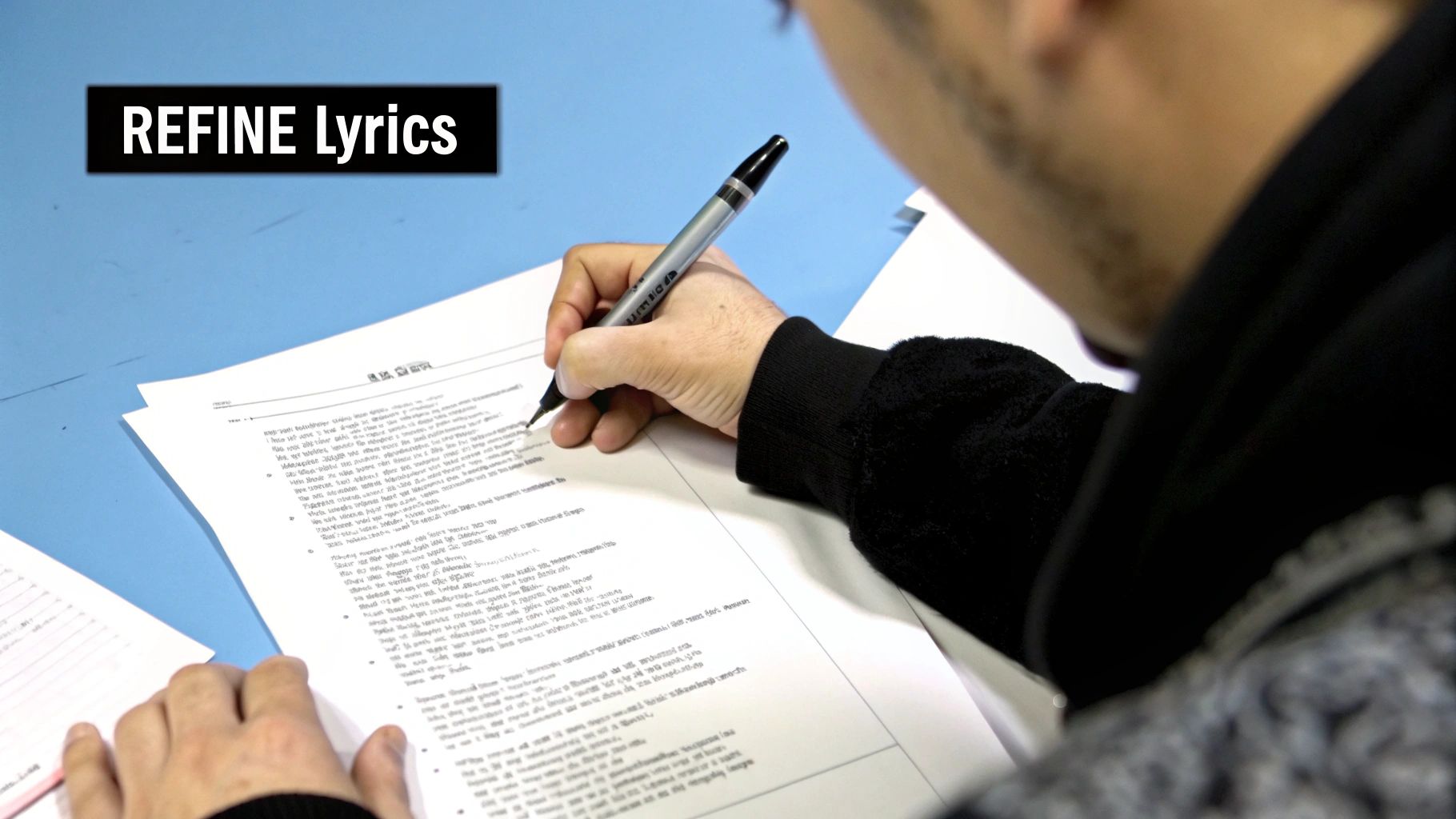
As you get deeper into songwriting, you're going to hit some walls. Every writer does, from the person just starting out in their bedroom to the pros with platinum records. It's a natural part of the process.
Let's tackle some of the most common questions that pop up. My goal here is to give you some straightforward, practical answers to get you unstuck and back to what matters: writing. Seeing these challenges as small breakthroughs in disguise is the key to moving forward.
What Should I Write First: The Music or the Lyrics?
Ah, the classic chicken-or-the-egg question of songwriting. The truth? There's no single right answer. The best method is whatever works for you and, just as importantly, whatever works for the song you're trying to write at that moment.
Starting with lyrics gives you total freedom to focus on the story, the message, and the specific words you want to use. You can craft your narrative without being boxed in by a melody or rhythm. This often results in really potent, message-driven songs where the words are the clear focus.
On the other hand, starting with a bit of music—a cool guitar riff, a simple chord progression, or a beat—can instantly set the mood. A somber piano line might pull words about loss out of you, while an energetic beat might demand lyrics about a wild night out. I often find it easier to "hear" the shape of the lyrics once the musical vibe is there.
My Advice: Don't chain yourself to one approach. If you usually start with words and you're feeling stuck, grab your instrument and just loop a couple of chords. See what happens. The best process is the one that gets the song written.
How Can I Find My Unique Songwriting Voice?
This is a big one. Your "voice" isn't something you go out and find like a lost set of keys; it's something you uncover over time. It’s already there, buried in the way you talk, your sense of humor, your specific life experiences, and your unique view of the world. The trick is to stop trying to sound like your heroes and start trying to sound more like yourself.
Here are a few ways to start peeling back the layers:
- Write about what you know. The most compelling stories are the ones that are real to you. Honesty has a magnetic pull that listeners can't resist.
- Listen to yourself speak. What slang do you use? What are your favorite phrases? Weaving your natural speech patterns into your lyrics makes them feel authentic and grounded.
- Lean into your quirks. Are you a hopeless romantic? Do you have a dark, sarcastic wit? Whatever it is that makes you you, don't hide it. That's your secret weapon.
Your voice will sharpen and change as you keep writing. The more songs you finish, the more you'll shed the skin of your influences and let your own perspective shine through.
How Do I Know When a Song Is Finished?
Knowing when to step away from a song is an art in itself. It's easy to fall into the trap of endless tweaking. A song is rarely "perfect," but it can absolutely be "finished." For me, a song is finished when every single element—every word, every line, every section—is pulling its weight and serving the song's core idea.
Before you call it done, run it through this final checklist:
- Does it say what I meant to say? Does the final lyric successfully get the initial feeling or story across?
- Can I take anything out? Be ruthless. If you can cut a line or a word and the song doesn't fall apart, it probably didn't need to be there in the first place.
- Does it feel complete? Does the song take the listener on a satisfying journey, even a short one?
If you can confidently say "yes" to these, it's time to let it go. You could polish a song forever, but true growth comes from trusting your work and moving on to the next idea.
Ready to take your lyrics and turn them into polished, release-ready tracks? ChordX is your home base for everything from songwriting deep dives and beat-making tutorials to guides on studio gear and software. Explore our resources and unlock your full creative potential.
